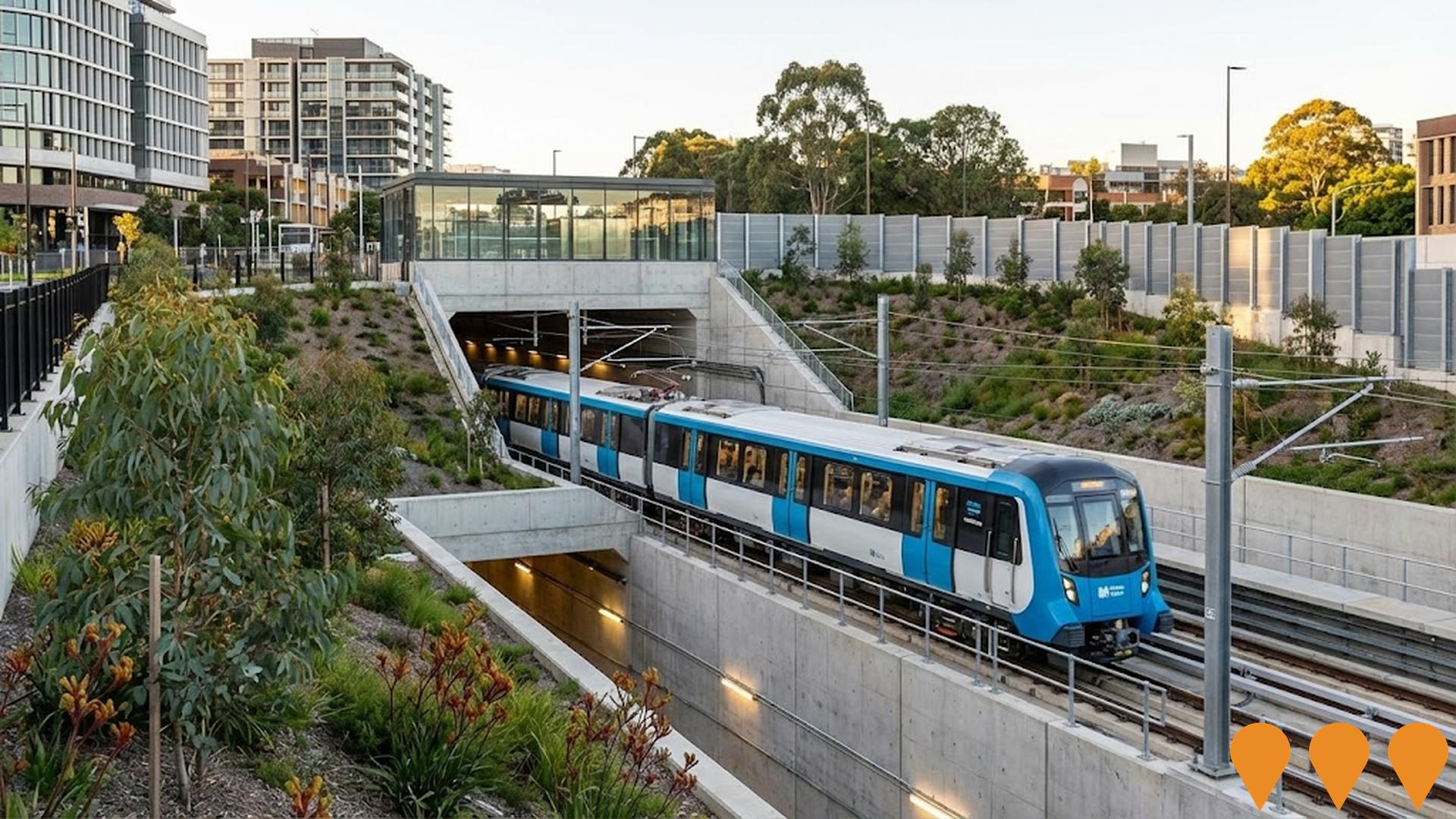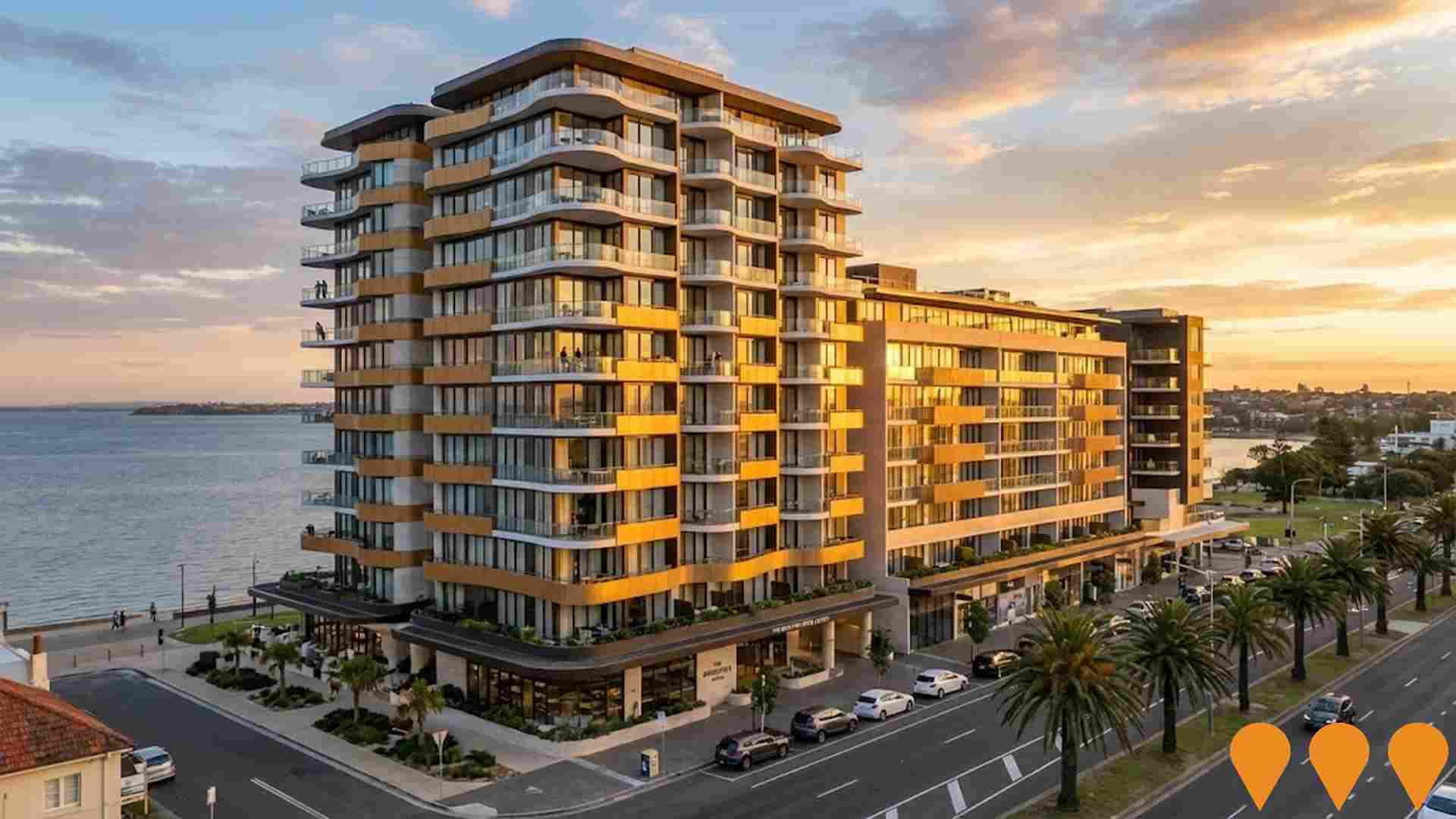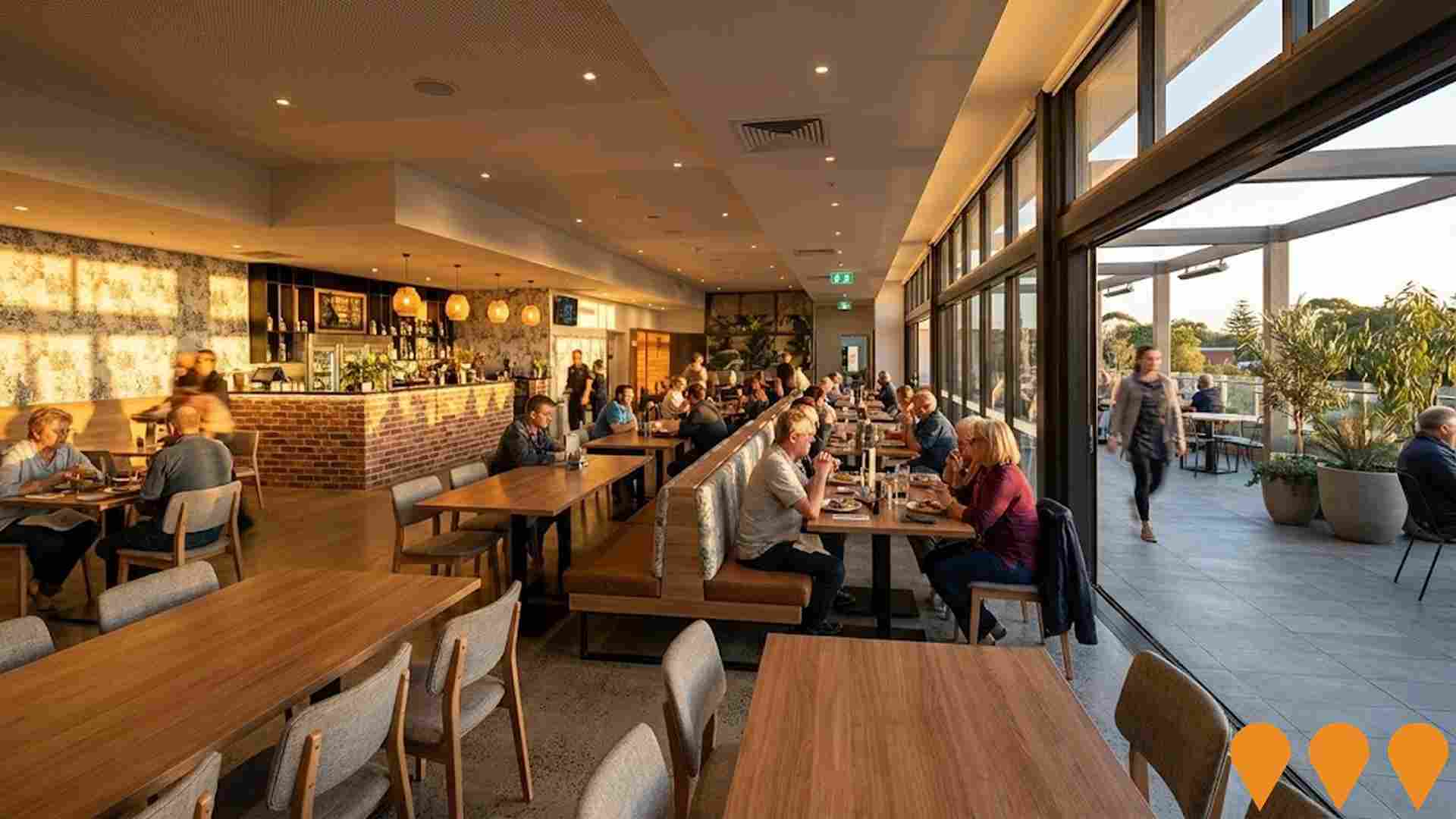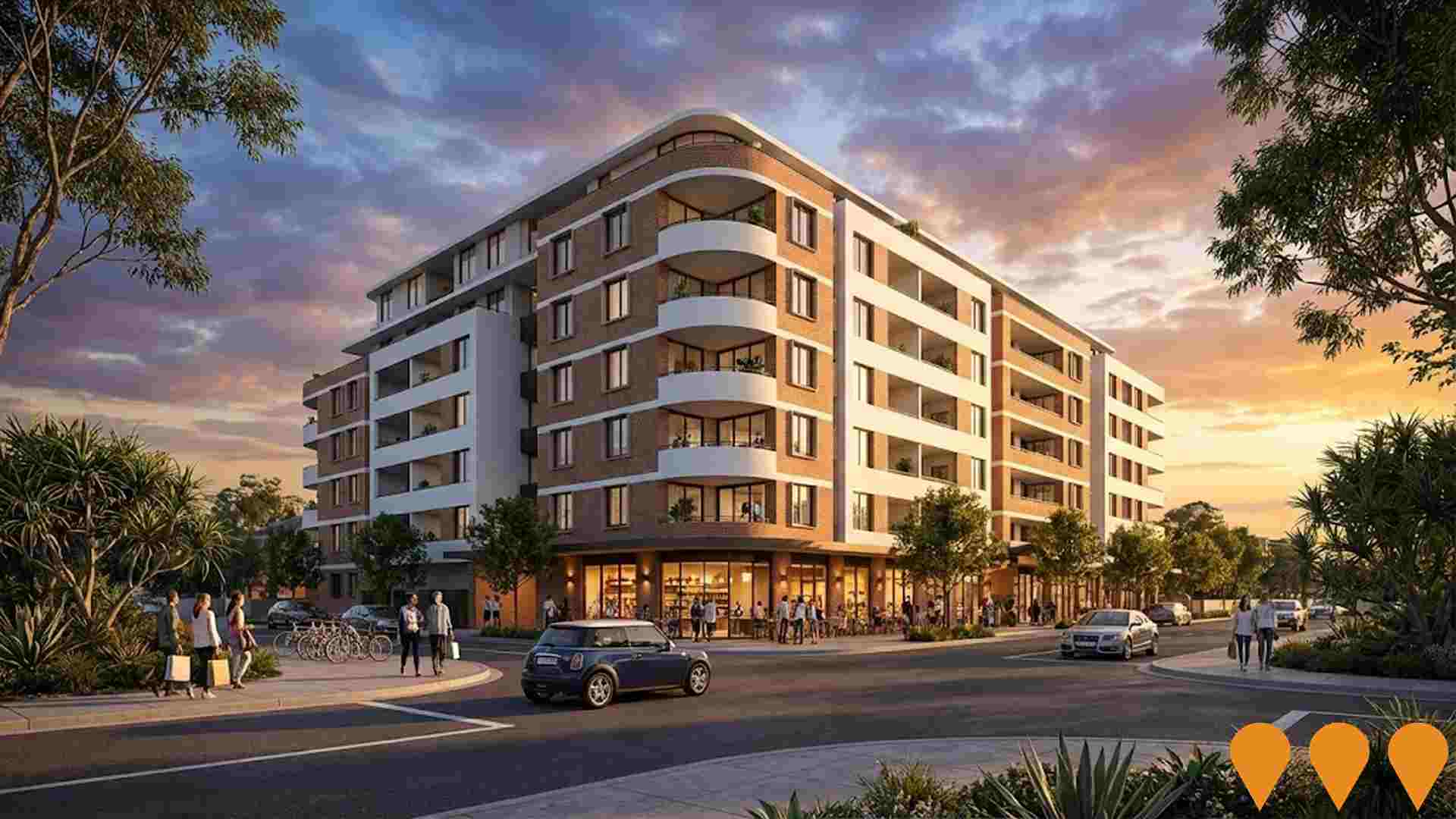Chart Color Schemes
est. as @ -- *
ABS ERP | -- people | --
2021 Census | -- people
Sales Activity
Curious about local property values? Filter the chart to assess the volume and appreciation (including resales) trends and regional comparisons, or scroll to the map below view this information at an individual property level.
Find a Recent Sale
Sales Detail
Population
Monterey - Brighton-le-Sands - Kyeemagh is positioned among the lower quartile of areas assessed nationally for population growth based on AreaSearch's assessment of recent, and medium term trends
Monterey - Brighton-le-Sands - Kyeemagh's population is approximately 13,719 as of Aug 2025. This represents a decrease from the 2021 Census figure of 13,896 people, a change inferred from ABS estimated resident population data and validated new addresses since then. The population density ratio is around 4,058 persons per square kilometer, placing it in the top 10% of locations assessed nationally. Overseas migration contributed approximately 86.3% of recent population gains. AreaSearch uses ABS/Geoscience Australia projections for SA2 areas released in 2024 with a base year of 2022.
For uncovered areas, NSW State Government's SA2 level projections from 2022 with a base year of 2021 are used. Growth rates by age group are applied to all areas until 2041. Future population trends indicate an expected expansion of the area by 382 persons to 2041, reflecting a total increase of approximately 2.6%.
Frequently Asked Questions - Population
Development
AreaSearch assessment of residential development drivers sees a low level of activity in Monterey - Brighton-le-Sands - Kyeemagh, placing the area among the bottom 25% of areas assessed nationally
Monterey-Brighton-le-Sands-Kyeemagh averaged approximately 37 new dwelling approvals per year. Between financial years FY-21 to FY-25188 homes were approved, with a further 12 approved in FY-26 so far. The population has been declining recently, suggesting that the new supply has kept pace with demand, offering buyers good choice.
The average expected construction cost value for new homes is $604,000, which is moderately above regional levels, indicating an emphasis on quality construction. In this financial year, $30.9 million in commercial development approvals have been recorded, reflecting robust local business investment. Compared to Greater Sydney, the area shows substantially reduced construction activity, with 52.0% below the regional average per person. This constrained new construction typically reinforces demand and pricing for existing homes. Nationally, this activity is also below average, suggesting the area's maturity and possible planning constraints. Recent construction comprises 45.0% detached houses and 55.0% townhouses or apartments, focusing on higher-density living which creates more affordable entry points for downsizers, investors, and first-home buyers.
The location has approximately 434 people per dwelling approval, reflecting its established nature. Projections indicate Monterey-Brighton-le-Sands-Kyeemagh is expected to grow by 353 residents through to 2041. At current development rates, new housing supply should comfortably meet demand, providing good conditions for buyers and potentially supporting growth beyond current population projections.
Frequently Asked Questions - Development
Infrastructure
Monterey - Brighton-le-Sands - Kyeemagh has very high levels of nearby infrastructure activity, ranking in the top 20% nationally
Changes in local infrastructure significantly impact an area's performance. AreaSearch has identified 26 projects likely to affect the area. Notable ones are Seychelles Brighton-Le-Sands, Moate Avenue Mixed Use Development, Bay Street Mixed-Use Development (271-275 Bay Street), and The Brighton Hotel Sydney Redevelopment. Below is a list of those most relevant.
Professional plan users can use the search below to filter and access additional projects.
INFRASTRUCTURE SEARCH
 Denotes AI-based impression for illustrative purposes only, not to be taken as definitive under any circumstances. Please follow links and conduct other investigations from the project's source for actual imagery. Developers and project owners wishing us to use original imagery please Contact Us and we will do so.
Denotes AI-based impression for illustrative purposes only, not to be taken as definitive under any circumstances. Please follow links and conduct other investigations from the project's source for actual imagery. Developers and project owners wishing us to use original imagery please Contact Us and we will do so.
Frequently Asked Questions - Infrastructure
Sydney Metro West
Sydney Metro West is a new 24-kilometre underground metro rail line connecting Greater Parramatta and the Sydney CBD. The project includes nine confirmed stations: Westmead, Parramatta, Sydney Olympic Park, North Strathfield, Burwood North, Five Dock, The Bays, Pyrmont, and Hunter Street. Construction is underway, with tunnelling progressing well, including the completion of the western end (Pyrmont to Westmead). The line will double rail capacity between Parramatta and the Sydney CBD, offering a target travel time of about 20 minutes between the two CBDs and aiming for a 'turn-up-and-go' service.

St George Hospital Redevelopment Stage 3
The $411 million St George Hospital Stage 3 redevelopment is delivering a new Integrated Ambulatory Care Precinct, which includes the 9-storey Kensington Street Building (KSB) with two levels of basement car parking. The KSB reached its highest point in December 2024. The facility will consolidate outpatient services, pathology collection, day rehabilitation, sub-acute and rehabilitation inpatient beds, aged care, acquired brain injury unit (Cognitive Transition Unit), palliative care, surgical services with refurbished operating theatres, enhanced diagnostic imaging, clinical skills centre, day infusion centre, outpatient pharmacy, emergency department expansion, modernised clinical facilities, and improved patient access. The name of the new building was changed from the Ambulatory Care Building to the Kensington Street Building (KSB) in January 2024 to avoid confusion with the existing Acute Services Building (ASB).

Northern Georges River Submain Upgrade
Critical wastewater infrastructure upgrade to the Northern Georges River Submain (NGRS), a major concrete sewer network in Sydney's south west. The work involves relining and renewing sections of the large-diameter pipeline (up to 2.5m in diameter) due to corrosion from sewage gas (H2S attack). This trenchless technology renewal work is part of a broader, long-term program to increase network capacity in the NGRS and Malabar System, improving system resilience and environmental performance by reducing wet weather discharge and odour emissions.

Seychelles Brighton-Le-Sands
Luxury beachfront development featuring 36 one, two and three-bedroom apartments, two spectacular penthouses, and five meticulously restored heritage-listed terraces originally built in the late 1880s by Thomas Saywell. The 13-storey development by Abadeen Group and JDH Capital is located directly opposite Lady Robinson Beach on The Grand Parade, with three levels of basement parking and panoramic views from Botany Bay to the city skyline.

The Brighton Hotel Sydney Redevelopment
Multi year redevelopment of the former Novotel Sydney Brighton Beach and adjoining Bayside Plaza into The Brighton Hotel Sydney, a 307 room beachfront MGallery hotel with upgraded rooms and suites, new ballrooms, refreshed pool and wellness facilities, and multiple new food and beverage venues including Ammos, Sands Bar, Beach Club and lobby bars. The project delivers a resort style waterfront destination on Botany Bay focused on leisure, events and conferences.

Brighton RSL Memorial Club Redevelopment
Extensive redevelopment and refurbishment of the Brighton Le Sands RSL Club building and memorial court, delivering a modern community club with upgraded dining spaces, sports lounge, refreshed gaming areas and enhanced memorial facilities while maintaining its role as a social hub for locals and veterans. Sources: club history and refurbishment case studies. :contentReference[oaicite:0]{index=0} :contentReference[oaicite:1]{index=1} :contentReference[oaicite:2]{index=2}

Bay Street Mixed-Use Development (271-275 Bay Street)
130-apartment development on a 4,000sqm amalgamated site comprising four properties. The 15,500sqm development by Vanis Holdings Pty Ltd includes three ground-floor retail premises and will be the second-tallest building in Brighton-Le-Sands at 13 storeys, connecting to existing Brighton Shores apartment complex.

588-592 Princes Highway Mixed-Use Development
Demolition of existing buildings and construction of part 10 and part 13 storey mixed use building comprising 129 residential units, ground floor commercial tenancies, basement parking, and Planning Agreement for dedication of the local road widening.

Employment
The labour market in Monterey - Brighton-le-Sands - Kyeemagh demonstrates typical performance when compared to similar areas across Australia
Monterey-Brighton-le-Sands-Kyeemagh has a well-educated workforce with professional services strongly represented. The unemployment rate was 3.6% as of June 2021 and the estimated employment growth over the past year was 2.2%.
As of June 2025, 8,170 residents are employed with an unemployment rate of 3.6%, which is 0.6% below Greater Sydney's rate of 4.2%. Workforce participation is somewhat lower at 55.2% compared to Greater Sydney's 60.0%. Leading employment industries include health care & social assistance, construction, and retail trade. The area has a notable concentration in transport, postal & warehousing with employment levels at 1.6 times the regional average.
However, professional & technical services employ only 9.1% of local workers, below Greater Sydney's 11.5%. Employment opportunities locally may be limited as indicated by the count of Census working population vs resident population. In the 12-month period ending June 2025, employment increased by 2.2% while labour force increased by 2.6%, causing the unemployment rate to rise by 0.4 percentage points. Greater Sydney recorded employment growth of 2.6%, labour force growth of 2.9%, and an unemployment increase of 0.3 percentage points during this period. Jobs and Skills Australia's national employment forecasts from May 2025 project national employment growth of 6.6% over five years and 13.7% over ten years. Applying these projections to Monterey-Brighton-le-Sands-Kyeemagh's employment mix suggests local growth of approximately 6.7% over five years and 13.7% over ten years, though this is a simple weighting extrapolation for illustrative purposes and does not account for localised population projections.
Frequently Asked Questions - Employment
Income
Income levels align closely with national averages, indicating typical economic conditions for Australian communities according to AreaSearch analysis
Monterey - Brighton-le-Sands - Kyeemagh had a median taxpayer income of $51,065 and an average of $64,651 in financial year 2022. This is roughly the national average, compared to Greater Sydney's median income of $56,994 and average income of $80,856. By September 2025, adjusted for Wage Price Index growth of 12.61%, estimated incomes would be approximately $57,504 (median) and $72,803 (average). According to the 2021 Census, incomes in Monterey - Brighton-le-Sands - Kyeemagh rank modestly, between the 44th and 52nd percentiles for household, family, and personal incomes. The income bracket of $1,500 - 2,999 is dominant, with 30.1% of residents (4,129 people), similar to regional levels at 30.9%. Housing affordability pressures are severe, with only 80.2% of income remaining, ranking at the 40th percentile. The area's SEIFA income ranking places it in the 6th decile.
Frequently Asked Questions - Income
Housing
Monterey - Brighton-le-Sands - Kyeemagh features a more urban dwelling mix with significant apartment living, with above-average rates of outright home ownership
In Monterey-Brighton-le-Sands-Kyeemagh as of the latest Census, 37.2% of dwellings were houses while 62.9% consisted of semi-detached homes, apartments, and other types. This contrasts with Sydney metro's figures of 39.8% houses and 60.3% other dwellings. The home ownership rate in the area was 34.7%, with mortgaged properties at 26.4% and rented dwellings at 38.9%. The median monthly mortgage repayment was $2,484, higher than Sydney metro's average of $2,383. The median weekly rent in the area was $450, compared to Sydney metro's $480. Nationally, Monterey-Brighton-le-Sands-Kyeemagh had significantly higher mortgage repayments at $2,484 versus Australia's average of $1,863, and substantially higher rents at $450 compared to the national figure of $375.
Frequently Asked Questions - Housing
Household Composition
Monterey - Brighton-le-Sands - Kyeemagh features high concentrations of lone person households, with a lower-than-average median household size
Family households comprise 63.9% of all households, including 27.2% couples with children, 23.4% couples without children, and 12.0% single parent families. Non-family households account for the remaining 36.1%, with lone person households at 32.7% and group households comprising 3.3%. The median household size is 2.3 people, smaller than the Greater Sydney average of 2.6.
Frequently Asked Questions - Households
Local Schools & Education
The educational profile of Monterey - Brighton-le-Sands - Kyeemagh exceeds national averages, with above-average qualification levels and academic performance metrics
Monterey - Brighton-le-Sands - Kyeemagh has 30.9% of residents aged 15 and above holding university degrees, compared to the SA3 area's 38.7%. Bachelor degrees are most common at 21.5%, followed by postgraduate qualifications (7.4%) and graduate diplomas (2.0%). Vocational credentials are held by 31.4% of residents aged 15 and above, with advanced diplomas at 12.7% and certificates at 18.7%. Current educational participation is high at 27.3%, including 8.2% in primary education, 6.4% in secondary education, and 5.4% pursuing tertiary education.
The area's four schools have a combined enrollment of 936 students as of the latest data. The socio-educational conditions are above average (ICSEA: 1060). There are three primary schools and one K-12 school in the area. School places per 100 residents stand at 6.8, below the regional average of 11.4, indicating some students may attend schools in nearby areas.
Frequently Asked Questions - Education
Schools Detail
Nearby Services & Amenities
Transport
Transport servicing is moderate compared to other areas nationally based on assessment of service frequency, route connectivity and accessibility
Monterey - Brighton-le-Sands - Kyeemagh has 90 active public transport stops. These stops are served by a mix of buses along six different routes. The total number of weekly passenger trips provided is 1,112.
Residents' accessibility to transport is rated excellent, with an average distance of 121 meters to the nearest stop. Service frequency across all routes averages 158 trips per day, equating to about 12 weekly trips per individual stop.
Frequently Asked Questions - Transport
Transport Stops Detail
Health
The level of general health in Monterey - Brighton-le-Sands - Kyeemagh is notably higher than the national average with both young and old age cohorts seeing low prevalence of common health conditions
Monterey - Brighton-le-Sands - Kyeemagh shows above-average health outcomes for both young and elderly residents.
Common health conditions have a low prevalence in this area, which has approximately 52% private health cover, higher than the average SA2 region (~7,120 people). The most prevalent medical conditions are arthritis (7.7%) and diabetes (5.4%). About 73.5% of residents report no medical ailments, compared to 77.5% in Greater Sydney. Residents aged 65 and over make up 21.9% of the population (3,007 people), higher than Greater Sydney's 16.4%. The health outcomes among seniors are strong and align with the general population's profile.
Frequently Asked Questions - Health
Cultural Diversity
Monterey - Brighton-le-Sands - Kyeemagh is among the most culturally diverse areas in the country based on AreaSearch assessment of a range of language and cultural background related metrics
Monterey-Brighton-le-Sands-Kyeemagh has a high cultural diversity, with 43.1% of its population born overseas and 51.6% speaking a language other than English at home. Christianity is the main religion in Monterey-Brighton-le-Sands-Kyeemagh, accounting for 68.2% of people, compared to 51.8% across Greater Sydney. The top three ancestry groups are Other (20.9%), Greek (16.5%), and Australian (12.0%).
Notably, Spanish (1.6%) and Serbian (1.7%) are overrepresented compared to regional averages of 0.9%. Macedonian is also present at 3.1%, slightly higher than the regional average of 3.8%.
Frequently Asked Questions - Diversity
Age
Monterey - Brighton-le-Sands - Kyeemagh hosts an older demographic, ranking in the top quartile nationwide
Monterey - Brighton-le-Sands - Kyeemagh has a median age of 44, which is higher than Greater Sydney's figure of 37 and significantly exceeds the national norm of 38. The area shows strong representation in the 55-64 age group at 13.4%, compared to Greater Sydney, while the 25-34 cohort is less prevalent at 12.4%. According to the 2021 Census, the population aged 15 to 24 has grown from 9.6% to 10.6%, whereas the 35 to 44 age group has declined from 14.8% to 13.8%. By 2041, demographic modeling suggests that Monterey - Brighton-le-Sands - Kyeemagh's age profile will change significantly. The 75 to 84 age group is projected to grow by 31%, reaching 1,459 people from the current 1,116. This growth is largely driven by an aging population dynamic, with those aged 65 and above comprising 91% of the projected growth. Meanwhile, the 45-54 and 15-24 age cohorts are expected to experience population declines.




